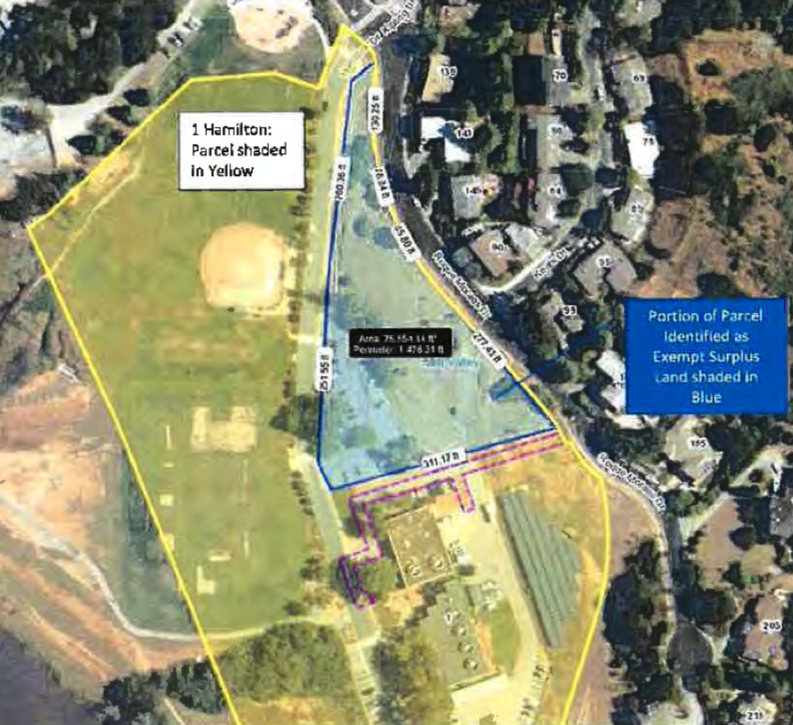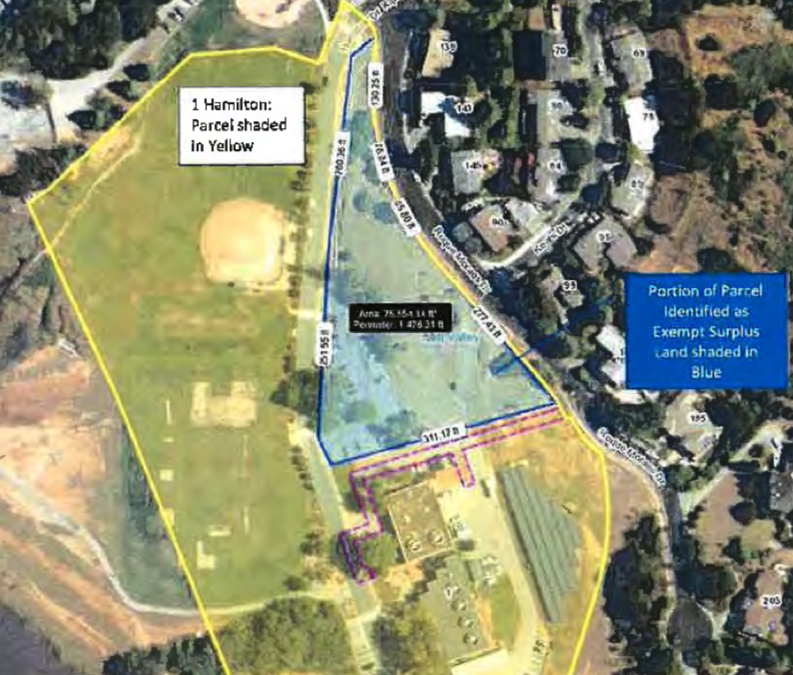
The Council delcared the portion of 1 Hamilton Drive shaded in blue exempt surplus land.
Can the City of Mill Valley successfully create conditions to ensure that dozens of people who work in Mill Valley but cannot afford to live here can do so, thus expanding opportunity and reducing traffic?
The City Council took a significant step forward Monday night, declaring a City-owned portion of 1 Hamilton Drive as “exempt surplus land,” a necessary legal step allowing them to take proposals for the site. To do so, the City must use at least 80 percent of the parcel for housing; make at least 40 percent of the total number of units affordable to households with incomes equal to or less than 75 percent of the max income of lower income households; and at least half of which shall be affordable to very low-income households.
It then selected EAH Housing, the lone submission to the City’s RFQ (Request for Qualifications) for potential developer partners on the site, and directed City Manager Alan Piombo to work out an Exclusive Negotiating Agreement (ENA) to establish the terms of the partnership for the potential lease or sale of property and development of affordable rental housing there. EAH Housing’s CEO is Mill Valley resident Laura Hall.
The Council’s deliberations on the items were relatively brief, and council members continued to emphasize the exploratory nature of this stage of the process.
“We are engaging with EAH and the community about how we are going to go about this,” Councilmember Urban Carmel said. “That’s where we are in this process. Environmental issues, traffic, parking required, height, bulk and mass of the development – all of these are critical issues. They will be studied and addressed. If traffic cannot be mitigated and parking can not be found, then we’re not going to have a project that can proceed. That’s where we are right now. This has to work for the community around that area. Otherwise it will be an us and them situation going forward.”
Councilmembers also sought to dispel the notion that a development at 1 Hamilton Drive would be the lone effort to address the City’s efforts to create conditions for more affordable housing. Hamilton Drive-area residents have pushed City officials to explore other neighborhoods and housing opportunities before doing so in their part of town, which has a history of multi-use and some affordable developments.
“It’s clear that this Hamilton project is a mess,” said Kipling Drive resident David Wygant. “We have the opportunity tonight to clean it up. True leadership comes from admitting mistakes. We need to open up a real dialogue with the community.”
Councilmembers have countered that the Hamilton Drive site shows the most promise as a City-owned parcel in proximity to transit corridors and commercial areas, but that all other options are on the table. “This is not going to be the only site we will look at for affordable housing,” Carmel added, noting that other sites, like the Edgewood Reservoir, the Miller Avenue commercial corridor and areas around the Mill Valley Golf Course and Boyle Park tennis courts, are potentially on the table.
“We don’t have the depth of staff to go any further without a partner like EAH Housing,” Mayor John McCauley, noting that the biggest cost associated with creating housing is the cost of the land, a huge reason to do so on City-owned land. “We haven’t done this as a town in nearly 25 years. If we’re serious about making a development happen, now’s the time to decide if our town is committed to creating below market rate housing on the site. This action will allow us to have a bigger conversation about those things.”
David Levin, an affordable housing advocate who also lives in the Enchanted Knolls neighborhood near the proposed site, said “there no one in this room who thinks we don’t desperately need this housing. I’m confident that this will be an extremely valuable asset for Mill Valley. It has a projected opening date for 2025. Someone said there is railroading going on here – but it’s definitely not a bullet train.”
The elephant in the room for these discussions remains the super-charged nature of the statewide focus on creating more housing, particularly on the heels of Gov. Newsom’s post-recall signing of SB9, which would allow property owners to build up to two duplexes on what was once a single-family lot.
. As the City embarks on a new Housing Element for years 2023-2031, a long-term, state-mandated deep dive into the future of housing in our community, the City is faced the Association of Bay Area Governments’ Regional Housing Needs Allocation that calls for an eye-popping increase in the number of units to be planned for by Mill Valley, from 129 units in the 2014-2022 cycle to 865 units in the 2023-2031 cycle (the City has appealed that allocation).
“We have to do everything we can now to get this done,” former Mayor Clifford Waldeck said. “If we don’t approve this project, it’s likely that we’ll fall well short of our RHNA numbers, even if they’re adjusted (on appeal). And if Mill Valley is not meeting its RHNA numbers, it could lose its local control and discretion and it might get 3-4 times the number of homes on that site. We should embrace the process and make it the best project we can possibly have, and then go on Miller Avenue and Boyle Park and so on.”
Whether it’s those RHNA number expectations or the community’s focus on following through on diversity, equity and inclusion initiatives that include addressing the lack of affordable housing in town, it’s clear that there is growing sentiment in favor of creatingmore housing opportunities in the 94941.
“There are so many misconceptions about affordable housing, what it looks like and who lives in it,” said Scott Highlands resident Tay Franklin, whose husband Matt Franklin serves on the City’s Housing Advisory Committee. “We’re excited to have this be an ‘and’ – we view it as ‘and.’
“I’m in support of continuing to explore this project, and I’m in support of exploring a project on Miller Avenue, and on the (Boyle Park) tennis courts and on (Mill Valley) golf course,” said Miller Ave. resident Simon Vansintjann.
Councilmember Sashi McEntee, who also lives in the affected neighborhood, put local opposition into the broader context of PG&E’s work to remove a vast amount of vegetation around its Alto power substation and its move forward with a plan to build a new, larger tower in the neighborhood to service Mill Valley. “There should be some acknowledgement that the neighborhood has had a lot coming at it all at once and all of that makes you less open to different possibilities,” McEntee said.
“There are only a few sites in town that you can do any kind of building,” she added. “This isn’t the only thing that the council will look at.”
City officials have remained steadfast that while they have already implemented housing initiatives like accessory dwelling units (ADUs), which have created an average of 20 units around the city each year, and the Covia “House Mill Valley” home share program throughout town, there is much more to do.
As it moves ahead with nrgotiations with the City, the EAH Housing team made it clear that there are a number of construction/design strategies and building types that they are interested in exploring with the community before settling on a design concept. The level of environmental review will be determined once the scope of the project is determined.



This article continues to put forward the false idea that the affordable housing will be for individuals working in Mill Valley. There is no ability to make this a requirement. The statement that traffic will be reduced is without any factual support.
This project is being fast tracked despite many hundred letters and speakers in opposition. Representative government is failing in our home-town. The size and scale is completely out of context for the neighborhood and the ruin of hauke park for the benefit of Mill Valley is obvious to anyone who has seen the mock-up drawings. Traffic, drought, ugly power stations, wildlife impact, lack of parking, are all factors that make the scale of this project a disaster. The proponents have said it’s a NIMBY situation, which is far from true. The neighborhood is in favor of affordable housing. We have the most affordable housing in this neighborhood in all of MV. The size of this proposal is untenable.
In my opinion this will greatly alter the Hauke Park area– not for the better
Looking forward to seeing the construction/design strategies and building types offering by the EAH Housing Team. An attractive design and lower profile building type should make the project more appealing to the community–especially when they factor in the knowledge that in this post-SB9 and SB10 environment, not meeting RHNA goals means having to deal with developers who will do what they want with their projects without community input, unlike the efforts being made now by the City and EAH.
It is very difficult to read the yellow letters in this item. Make them a bright color so that they stand out.